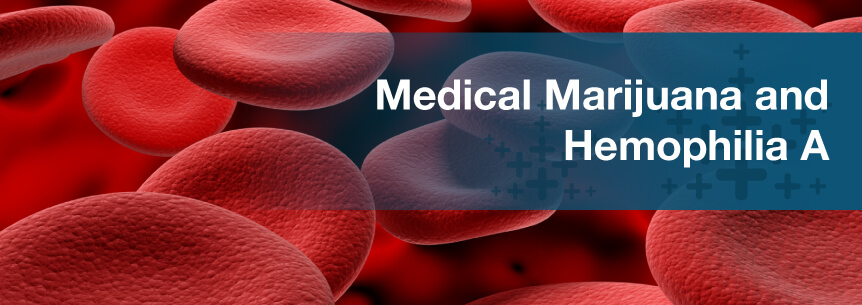
Hemophilia A is a hereditary disease in which a person’s blood does not clot normally, leading to prolonged bleeding episodes. Those suffering from hemophilia A are at risk of spontaneous bleeding and bleeding that does not stop naturally without medical treatment. Internal bleeding and bleeding into joints are also common with hemophilia A and lead to severe pain for patients.
Pain treatment for hemophilia A is limited, as over-the-counter painkillers are dangerous for those with blood clotting disorders. Medical marijuana can be an effective way to manage the pain of hemophilia A without the risk of complications. Medical cannabis may be an excellent option for you or a loved one who is living with hemophilia A.
Hemophilia is a genetic bleeding disorder caused by a lack of clotting proteins in the blood. There are two main types of hemophilia: hemophilia A and hemophilia B. Each type is associated with a deficiency of a different protein in the blood. Patients suffering from hemophilia A are deficient in a protein called factor VIII, which plays a crucial role in the process that causes blood to clot, called the coagulation cascade. During the coagulation cascade, a series of reactions occur between proteins and other factors in the blood that cause the blood to thicken and clot to stop bleeding. When a person is deficient in one of these clotting proteins, their body cannot stop bleeding, externally or internally.
Hemophilia A is a hereditary disease, meaning it is passed down from parents to their children. The gene associated with hemophilia A is X-linked recessive. That means the defective gene appears on the X-chromosome, and symptoms of hemophilia A will only occur if a person carries the disease on all their X-chromosomes.
Because men only have one X-chromosome, they are much more likely to suffer from hemophilia A than women. Women have two X-chromosomes, meaning they will only experience symptoms of hemophilia A if they inherit the disease from both their mother and father. Women who inherit just one X-chromosome with hemophilia A are called “carriers.” These women will not experience symptoms of hemophilia A, because they have a second healthy X-chromosome that can produce enough factor XIII to prevent them from experiencing blood clotting issues. However, if a carrier of hemophilia A has a son, that son has a 50 percent chance of inheriting the disease.
While women are less likely to suffer from hemophilia A, they are more likely to be carriers of the disease or pass it on to their children. If a carrier of hemophilia A has a son, there is a 50 percent chance her son will have hemophilia A. If a woman carrying hemophilia A has a daughter, that daughter will only have the disease if she also inherits a second X-chromosome carrying hemophilia A from her father. A daughter of a woman carrying hemophilia A has a 50 percent chance of being a carrier herself.
It is most common for people to inherit hemophilia A. However, in one out of three cases, hemophilia A occurs because of a random mutation that changes a person’s genes before they are born. Hemophilia A typically gets diagnosed at birth or in early childhood. In extremely rare cases, a person can develop hemophilia A later in life in a phenomenon called “acquired hemophilia A.” Acquired hemophilia A typically occurs in women after giving birth, or in both male and female patients in correlation to cancer or an autoimmune disease.
There are about 20,000 people in the U.S. living with hemophilia, and one out of every 5,000 babies is born with hemophilia. Compared to hemophilia B, hemophilia A is four times as common. More than half the people suffering from hemophilia A have a severe case.
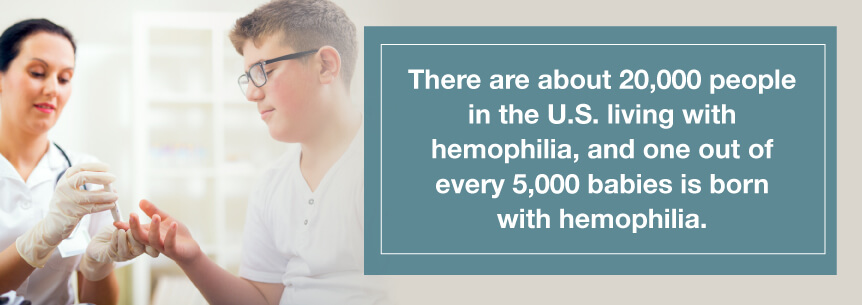
Severe cases of hemophilia A are cases in which the patient has less than 1 percent the normal amount of factor VIII in their blood. Patients with severe hemophilia A may not be able to cease bleeding after an injury without seeking medical help, and may experience spontaneous bleeding and bleeding into their joints.
Symptoms of hemophilia A vary depending on the severity of the disease, but typically include:
A person with mild hemophilia A may not receive a diagnosis until later in childhood, when they experience an injury that does not stop bleeding for an abnormally long time. Those with severe hemophilia A will notice heavy, prolonged bleeding after any cut or injury. Tooth extractions or other dental surgery are particularly prone to cause prolonged bleeding for people with hemophilia A. A person with severe hemophilia A will also notice a higher frequency of spontaneous bleeding episodes, or bleeding that occurs without a clear cause.
Those with severe hemophilia A are also at risk for complications if internal bleeding occurs in the brain, such as after bumping their head, falling or other head trauma. Some symptoms associated with bleeding in the brain are:
A person who experiences any of these symptoms should consider getting tested for hemophilia A, especially if there is a history of hemophilia A in their family. Testing for hemophilia A typically includes testing the blood’s clotting ability and reviewing the patient’s family history of the disease. These clotting tests examine the levels of factor VIII in the blood, as well as other factors that may inhibit clotting. They test how long it takes for the patient’s blood to clot and measure a person’s complete blood count. Tests for hemophilia A are also useful to determine the severity of the disease.
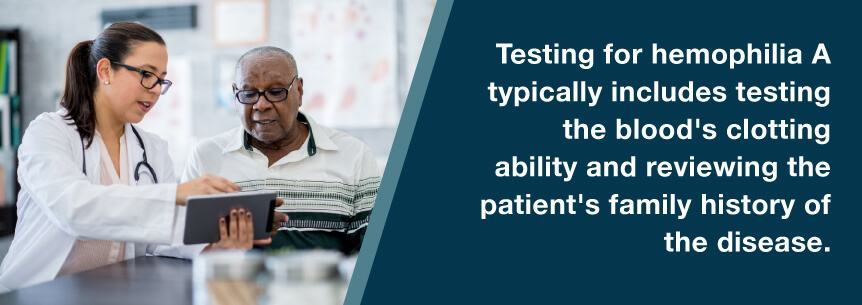
Traditional hemophilia A treatment involves replacement therapy that adds a concentrated version of factor VIII back into a person’s blood through an IV. These factor VIII supplements can derive from human blood plasma or get manufactured in a lab. Adynovate, for example, is a synthetic form of factor VIII commonly used for replacement therapy.
Those with severe hemophilia A must receive factor VIII treatments frequently to prevent spontaneous bleeding. Patients typically must go to a doctor’s office or clinic to receive factor VIII infusions, but in some cases, patients may be able to perform factor VIII replacement therapy at home. A person with mild or moderate hemophilia A may be able to rely on applying factor VIII infusions only when they experience an injury or begin bleeding spontaneously, rather than receiving infusions periodically.
While factor VIII infusions are generally effective, there is a 20 percent chance a patient’s body will reject the factor VIII after receiving treatment. In very rare cases, a patient may have an allergic reaction to the factor VIII concentrate. In these cases, the patient may need to find another source for the factor VIII or try a different dosage amount.
Other possible side effects of infusions of artificial factor VIII include:
A common supplementary treatment for hemophilia A is desmopressin acetate, or DDAVP. Doctors typically reserve DDAVP for mild cases of hemophilia A where a patient only needs treatment at the time bleeding occurs. A doctor can prescribe administration of this drug through injections or nasal sprays, and patients should take it as soon as they experience signs of bleeding. DDAVP helps release factor VIII stored in the cells lining the blood vessels, which helps promote healthy blood clotting. DDAVP is often reliable when a person with moderate or mild hemophilia A is having a dental or surgical procedure.
The effectiveness of DDAVP to treat mild bleeding episodes varies depending on the patient and the severity of their hemophilia A. Patients should take caution when relying on DDAVP to manage hemophilia A, as it may not be effective enough in certain patients to stop their bleeding. Some side effects of DDAVP include:
Other medicines used alongside factor VIII infusions include antifibrinolytic medicines that help prevent blood clots from breaking down once they form. These supplementary medicines can be taken orally and are intended to prevent bleeding from starting again once it has stopped. Common antifibrinolytic medicines include tranexamic acid and epsilon aminocaproic acid.
One of the most significant problems for those living with hemophilia A is pain management. Acute pain is common when patients experience bleeding episodes, nosebleeds or bleeding into a joint. Joint bleeding is one of the most common instances of spontaneous bleeding in those with severe hemophilia A, and accounts for 70 to 80 percent of spontaneous bleeding episodes. Bleeding into joints causes swelling and stiffness that can be extremely painful. Over time, frequent bleeding into joints and muscles can cause long-term damage to joints. Joint damage can also negatively impact bone health, both of which lead to chronic pain.
When patients with hemophilia A experience acute or chronic pain, their pain management options are limited. Those with hemophilia A cannot take over-the-counter painkillers, because many of them slow blood clotting, which counteracts the infusion of factor VIII and makes it even more difficult for the patient’s blood to clot. Additionally, if a patient experiences headaches or stomach pain as a side effect of hemophilia A treatments, they will not be able to take over-the-counter painkillers to alleviate their pain.
One way for those with hemophilia A to reduce their pain is to exercise and stretch regularly. Those with stronger muscles are less prone to injury, which means they reduce their chance of spontaneous internal bleeding. When a patient does experience bleeding into joints, they can ice and elevate the injury to reduce pain. However, these techniques do not provide immediate or complete relief from pain.
Medical marijuana cannot replace traditional treatments for hemophilia A, because factor VIII replacement therapy is necessary to promote proper blood clotting. However, medical marijuana can effectively fill the gap in pain management for those suffering from hemophilia A. Medical marijuana can also reduce other side effects caused by factor VII infusions. Medical marijuana can provide relief by:
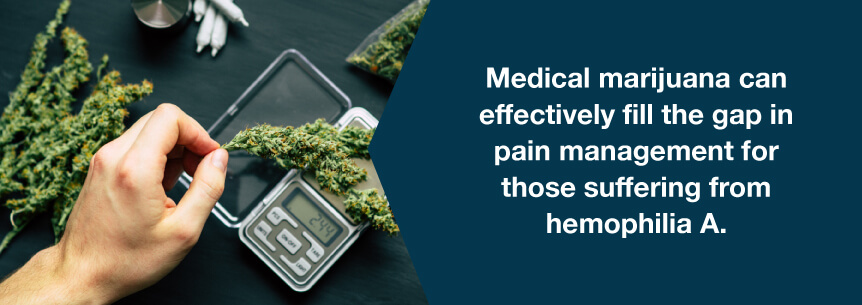
Cannabis for hemophilia A sufferers can effectively treat pain because the cannabinoids in marijuana bind to pain receptors in the nervous system and reduce pain signals to the brain. Medical marijuana also helps relax muscles to relieve joint stiffness and allow freer movement of muscles.
By choosing medical marijuana to treat the pain of hemophilia A, patients free themselves from dependence on other medications for pain treatment. Many pain medications contain opiates that can be addictive or cause withdrawal when a patient stops using them. Medical cannabis is non-addictive and will not cause withdrawal, which means patients can manage their chronic pain as needed and address acute pain whenever it occurs. Medical marijuana also offers immediate relief from the joint pain associated with hemophilia A that is not possible through exercise or stretching.
Different strains of medical marijuana can be more effective for treating hemophilia A, depending on what symptoms the patient is experiencing. Generally, patients who are suffering from joint and muscle pain should seek hybrid Indica-Sativa strains with a balance of cannabidiol (CBD) and tetrahydrocannabinol (THC). CBD has shown to be effective in reducing inflammation, easing joint stiffness and reducing pain in muscles and joints. Strains with high CBD content are often the best for managing pain, but can be more difficult to find at dispensaries because they are a relatively new addition to the medical marijuana field. THC sometimes has a negative reputation as being the component of marijuana that makes you feel “high.” However, THC also has powerful abilities to reduce pain, decrease stress and aid in the treatment of many diseases.
By opting for a hybrid strain, you can receive the benefits of both major cannabinoids without feeling impaired or fatigued. However, depending on your needs, Indica or Sativa strains can also be the best choice. Below are some strains that are effective for managing the symptoms of hemophilia A.
Choosing the right strain to treat your hemophilia A symptoms may take some trial and error. Everyone’s body reacts differently to medical cannabis, so you may need to try a few varieties before finding the perfect strain for your treatment plan. For more about how different strains can help manage pain and inflammation, check out our article on the best strains of medical marijuana.
One of the benefits of medical marijuana is that patients can ingest it in a variety of ways to suit their particular needs. Each method of consuming medical cannabis for hemophilia A has a slightly different effect, including the time it takes for the treatment to start, how long the relief lasts and how strong the effects are. Here are a few applications of medical cannabis that can help with treating hemophilia A.
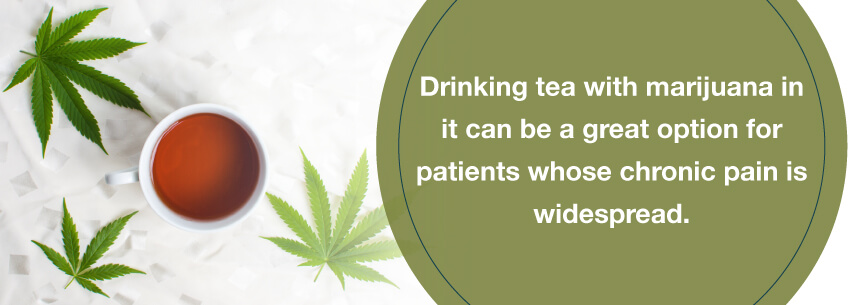
As with any medicine, medical marijuana has some possible side effects. These side effects are typically milder than side effects of traditional medications and do not last long. Some side effects of medical marijuana use may include:
In general, the benefits of pain relief and reduction of inflammation are greater than the discomfort of these mild side effects. However, a patient experiencing these side effects should consult their doctor about adjusting their dosage or trying a different strain. Often, switching to another strain or ingestion method can eliminate any side effects of medical cannabis.
More and more patients are turning to medical marijuana because it is a natural alternative to manufactured medications. Medical marijuana is effective in pain management and can be a great option for those suffering from chronic pain and inflammation associated with hemophilia A. Medical marijuana is non-addictive, so it is a safe alternative to opioid painkillers. The variety of ingestion modes make medical cannabis easy to integrate into any lifestyle of those living with hemophilia A.
If you are considering medical marijuana for hemophilia A, search for a medical marijuana doctor today to discuss your options.
Find A Doctor Find A Dispensary